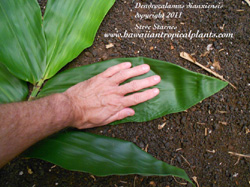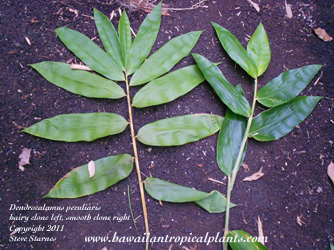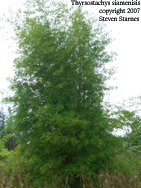 |
Bambusa boniopsis-This is a small species from Hainan island off the south coast of China. Culms reach
about 16 ft. tall and 1 inch in diameter. Narrow leaves. Straight at the base with noding tops. One of my favorites for small
spaces. Seems to tolerate drought and wind.
|
|
Bambusa distegia- Native to mountains of South China. Similar in appearance to Bambusa textilis.
Leaves are a bit longer. Young culms have lots of fine bristles. These wear off with age. Straight culms nod at the tops. Seems
to have some drought and wind tolerance. Good wind break.
Nice for medium sized yards. Culms can be split for weaving. Cold hardy to 15F or 16F.
|
|
Bambusa lako-Timor Black bamboo. Found on the island of Timor in Indonesia. this clumping black species has
shiny chocolate colored clums. Reaches about 45 to 50 ft. tall and 4 inches in diameter. Medium sized leaves. Very straight growth habit.
New culms can emerge as far as 2 ft. from the base. New shoots are medium green. Culms turn black as they mature.
of the clump.
|
|
Bambusa malingensis-Native to China. Culms reach to about 35 ft. tall and 2.5 inches in diameter.
Small leaves. Thick walled culms are strong and good for construction. Shoots are edible and good quality. Drought and wind tolerant.
Good choice for wind breaks. Grows well even in rocky areas.
|
|
Bambusa membranaceus- Native to Burma and Thailand. Smaller leaves
than many Dendrocalamus species. Culms up to 60 ft. tall and 4 inches in diameter. straight at the base and arching at the top.
Grown for high quality timber and edible shoots. Young culms are covered with white powder. Mature culms are medium green. Good potential for
wind break and reported to tolerate some salt spray near the coast. Fast growing. Clumps put out numerous shoots each year. c
|
|
Bambusa multiplex 'Silverstripe'-Small leaves with white stripes. New culms have white striping.
Small bamboo reaching about 25 ft. tall and 1.5 to 2 inches in diameter. New shoots have some pink and white striping. Drought and wind tolerant.
Good screen or hedge for privacy. Reported to be cold hardy to about 15F. There are numerous clones of B. multiplex. One of the most
popular is Alphonse Karr which is gold with green stripes.
|
|
Bambusa oldhamii 'Hirose'-There is till some debate over the identity of this clone. But it is almost
identical to B. oldhamii. It gets a little larger. It is a seedling of a plant that was growing at Hirose Nursery in Hilo, Hawaii; flowering occured in
the 1980s. Culms reach about 4.5 inches in diameter and 65 ft. tall. Medium sized dark green leaves. Tight clumps with very straight stems slightly arching
near the top.
|
|
Bambusa oliveriana- Native to India. Reaches 30 to 35 ft. tall and about 2.5 inches in diameter. Small leaves.
Dry windy conditions may cause some stress but plants recover quickly.
Dense clumps make a good privacy screen or short wind break. Culms are strong and thick walled. Shoots are edible and good quality.
|
|
Bambusa sp.- Native to Burma and India. We originally purchased these plants as B. burmanica but after growing out it appears to have been
mislabeled. There is still
much debate about the correct botanical classification of this plant. There seem to be 2 variants in the seedlings. As our plants are maturing, culms have cream colored stripes;
it will add some color to the garden or farm. The other variant is solid green. Used for edible shoots and timber. They make a good wind
break or privacy screen. When mature the culms reach aproximately 35 ft. to 40 ft. Lower portion of the culm
is almost solid and yields very strong building material. Our plants have small leaves in comparison to other species that we are
cultivating. Survives temperatures down to about 27F. Tolerates some drought with a little leaf drop. The seeds were imported in the late 1990s
from Laos by Quindembo Bamboo.
|
|
Bambusa sp.-Yet another one that appears to have been mislabeled. Obtained as B. edulis but isn't. Dense clumps of small culms.
Looks like this one will be a good hedge bamboo. It has been reported to reach about 10 ft. to 15 ft. in height.
In rocky areas with little soil, it will not get much more than about 8 ft. or 9 ft. Good choice for a container.
|
|
Bambusa ventricosa kimmei-Common Name: Buddha belly bamboo. This a a variegated bamboo that will
form buddha belly when stressed. In the ground in rich soil, it tends to be straight with arching tops. Yellow culms with green stripes. In our rain forest environment
with high humidity, it is showing little sign of bellying. Good quality edible shoots. Reaches 50 ft. and 2.5 inches in diameter. Cold hardy to 18 F.
|
|
Cephalostachyum pergracile- Common Name: Tinwa bamboo. Slender culms to about 30 ft. Culms are used as a vessel to cook rice.
Large leaves. Also, used for light construction. Culms are spit and used to weave baskets. Just added this one to my collection in early 2009. Has been a bit slow
to establish but it is growing on rock with little soil.
|
 |
Dendrocalamus asper 'Indonesian Clone'-Giant clone of D. asper. This clone has no record of flowering. Larger than Thai sourced clones.
Reaches up to 100ft. tall and up to 12 inches
in diameter. Fast growing. Best growth is in good soil. It even tolerates growing in a pile of lava rock on my farm with minimal
mulching. Recovers quickly from droughts. High quality edible shoots. Excellent timber.
|
 |
Dendrocalamus brandesii- Native to India. Very tall species up to
or exceeding 100 feet; culms to 8 or 9 inches in diameter. Lower part of culms is covered in dense whitish fuzz. Large leaves.
Excellent quality edible shoots. High quality timber. Best in rich soil. Plants look their best during rainy periods. Shows signs of stress under dry windy conditions. Cold hardy to
about 27F or 28F.
|
 |
Dendrocalamus dianxiensis- Native to southern China. Large wide leaves. Undersurface has a felt like feel. Some hairs on the upper surface.
Fast growing once established. Reaches 60 to 70 ft. tall and 5 to 7 inches in diameter. Full sun to light shade. Keep moist. Likes a position protected from wind. Reported to tolerate
some frost; probably 27F.
|
|
Dendrocalamus latiflorus- Native to southern China. Culms reach 8 inches in diameter and up to 80ft. tall.
Smooth green straight culms. Large smooth leaves. New shoots have few hairs and are a bright light to medium green. This species does not tolerate much wind or drought. For the best appearance make
sure to plant this one in a location protected from wind. Prized for high quality shoots and good timber. Cold hardy to only 27F or 28F.
|
 |
Dendrocalamus peculiaris- Large wide leaves. Undersurface has a felt like feel. Some hairs on the upper surface.
Fast growing once established. Reaches 50 to 60 ft. tall and 4 to 5 inches in diameter. It appears that I have a mixed population; possilby 2 species in this batch. Both have very
large leaves. One clone has whitish stems and more dark brown hair on the culm sheath; leave upper surface has some tiny stiff hairs. The other clone has smooth green stems and less
brown hair on the culm sheath
|
|
Dendrocalamus sp.- Possibly D. strictus. However, the seeds appeared different than other D. strictus
selections (communication with Susan and Peter at Quindembo Bamboo) and it is reported to reach a larger size. Reported to be
used for edible shoots and timber. Fast growing large bamboo. Culms are very straight and erect in the lower portion and arching at the top. Medium sized leaves have a soft velvety feel. It will probably reach
70 ft. or more in height with culms 8 to 10 inches in diameter. Young clumps only put up 2 or 3 shoots per year. We are growing in lava rock with
very little soil or mulch. Growth is always faster in areas with good soil.
|
 |
Dendrocalamus tibeticus- Large wide leaves. Undersurface has a felt like feel. Reaches 70 to 80ft. tall and 7 to 9 inches in diameter.
Culm sheath has lots of dark brown hair. Culms are smooth and dark green in young plants. Full sun to light shade. Keep moist. Likes a position protected from wind. Reported to tolerate
some frost; probably 26 to 27F. Fast growing once established. Native to lower elevations in Tibet and may extend into part of Yunnan province.
|
 |
Dendrocalamus yunnanicus- Large wide leaves but usually not as wide as in D. tibeticus. Undersurface has a felt like feel.
Reaches 70 to 80ft. tall and 7 to 9 inches in diameter.
Culm sheath has some dark hairs but less than D. tibeticus. Culms are smooth and dark green in young plants. Full sun to light shade. Keep moist. Likes a position protected from wind. Reported to tolerate
some frost; probably 26 to 27F. Fast growing once established. Native to lower and mid elevations in southern Yunnan province.
|
|
Drepanostachyum khasianum-Native to Northern India. This lovely ornamental species reaches about 16 ft. with culms
about 1/2 inch in diameter. Culms are dark purplish beneath each internode. Moderatly arching culms. Best in afternoon shade in hot areas.
Likes moist soil with plenty of organic matter. Excellent container plant. Cold hardy to about 21 F.
|
 |
Fargesia sp.- Got this one labeled F. yunnanensis but is probably F. communis. It may be another Fargesia sp. Mountain species native to mid to high elevations in Yunnan province. Slender 2 inch culms reaching about 25 ft. tall.
Prefers some shade in hot climates. Seems to be ok with days in the mid-80s. Cold tolerant; reported to take frost down to about 10F.
We have no chance to test cold tolerance in Hawaii. It seems to be ok from just above sea level to 4,000 or 5,000 ft. on the east side (windward side) of the Big Island.
Leaves, culm sheath and growth habit similar to other Fargesia species. My best guess is that this will be a medium sized bamboo around 15 ft. tall.
|
 |
Gigantochloa albociliata-This very nice smaller species reaches about 25 ft. Culms reach 2 to 2.5 inches in
diameter. Straight at the base but the tops become thin and arch back almost to the ground. Shoots are sweet and high quality. Each spring
numerous shoots are produced. Moderate drought and wind tolerance. Prolonged dry windy weather will stress the plants.
|
 |
Gigantochloa atter-Native to the island of Java (the capital of Indonesia is locate on this island). Deep green culms reach
6 inches in diameter and 50 to 60 ft. tall. Very straight with just a little noding at the very top. Large leaves. Tolerates some wind and drought. Grows well even in rocky soil.
Good quality timber with strong thick walls. Shoots are sweet and high quality.
|
|
Gigantochloa luteostriata-Nice smaller species reaching about 25 ft. with culms 2.5 inches in diameter.
Some cream striping on the lower culms. New shoots are green white and pink striped. Medium sized leaves with some white stripes. Prefers a very moist location. Best with some
afternoon shade. Does not tolerate drought or a very windy location. Very nice ornamental species for a small or medium sized yard.
|
 |
Gigantochloa pseudoarundinacea-This is a large clone of G. psedoarundinacea reaching almost 100 ft. tall.
Cream and green stripes on lower culms. Huge leaves. Striking ornamental for the tropical garden. Fast growing. Some tolerance to drought and wind. Thick
culm walls. Very good quality edible shoots. Strong timber. Reported to be cold tolerant to about 28F.
|
 |
Guadua angustifolia-Native to South America. Often found in mountain river valleys. Large thick walled species
grown for very high quality straight timber. Some resistant to boring insects. Large culms up to 90 ft. and 10inches
in diameter. Very dark green culms have thick white ring at the node. This species has thorns but they are well above head height
in a mature clump. Tends to have more space between culms. New culms emerge about 3ft. from the old ones in a mature stand. Tends
to stress under drought conditions. But I am growing in lava rock with almost no soil. Probably better in areas with deeper soil.
|
|
Himalayacalamus hookerianus-Common Name: Blue bamboo. Native to northern India. Slender culms reaching about 20 ft. tall
and 0.8 inches in diameter. New culms have a bluish appearance. These plants grow at high altitudes and are best with mid-day and afternoon shade in
hot areas. Dark green narrow leaves. This one died during a period of hotter than normal weather; I had it in too much sun.
|
|
Melocalamus arrectus-Native to high elevations in southeastern China. Large leaves. Culms are straight
at the base but become narrow and pendant at the top. Leaves are large; up to 4 inches wide and 10 to 14 inches long. Leaf backs have
hints of red. Likes some shelter from wind and hot afternoon sun. Best in rich moist soil althought it tolerates our lava rock with
regular applications of mulch and fertilizer.
|
|
Oxytenanthera abbysinica- Common Name: Wine Bamboo. Native to eastern Africa. Lower culms have some white fuzz.
Medium green smooth leaves. Up to 30 ft. and 4 inches in diameter. Might become a bit larger in Hawaii. A nice landscape specimen in the tropics. New culms are cut and the sap is collected to produce a beer or wine
like drink. Drought tolterant but will drop most leaves during prolonged dry periods. Probably tolerates a couple of degrees of frost.
|
 |
Schizostachyum brachycladum-Common Name: Balinese sacred bamboo. Striking butterscotch yellow culms with
large leaves. New culms are very bright yellow but fade a little as they mature. New leaves have cream striping. Tight clumps with very
straight culms. Thrives in warm humid areas of the tropics. Reaches about 45 ft. tall and 4 inches in diameter. This species blooms
every year but does not die after flowering. Full sun or light shade. Best in an area protected from high winds. Does not tolerate
freezing.
|
 |
Schizostachyum jaculans- Native to Indonesia. Very straight dark green culms with large leaves. Long
internodes. Plants reach about 25 ft. and 1.5 inches in diameter. Best in an area sheltered from wind. Prefers moist conditions and
doesn't appear to have much drought tolerance. Does not tolerate freezing temperatures.
|
 |
Thyrsostachys siamensis-Common Name: monastery bamboo. Native to Thailand.
High quality timber and edible shoots. Grown as a wind break. Culms reach about 45 ft. and 3 inches in
diameter. Culms are almost solid at the base. Fine leaves. Tight clumps are erect at the base and arch outward at the top.
Tolerates periods of dry windy weather.
|
 Hawaiian Tropical Plant Nursery, LLC
Hawaiian Tropical Plant Nursery, LLC

 Hawaiian Tropical Plant Nursery, LLC
Hawaiian Tropical Plant Nursery, LLC
